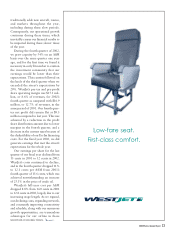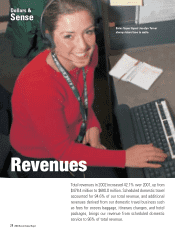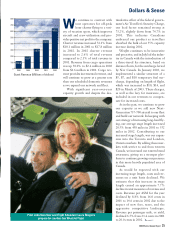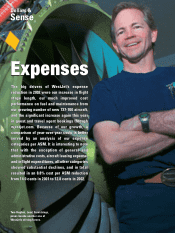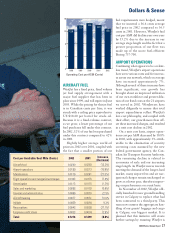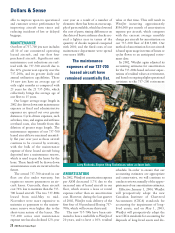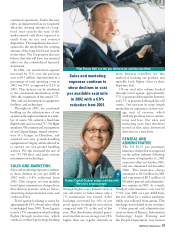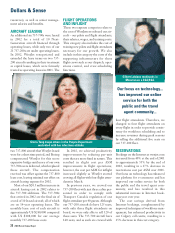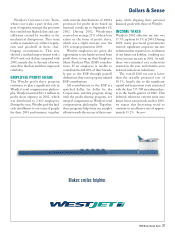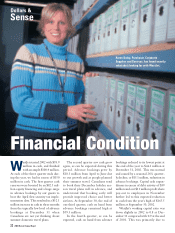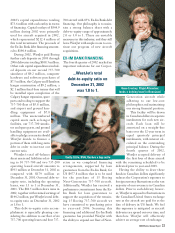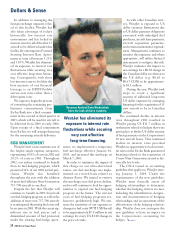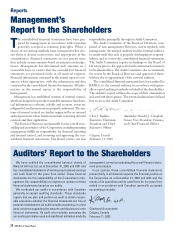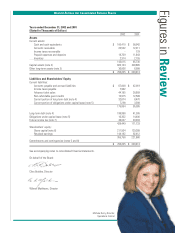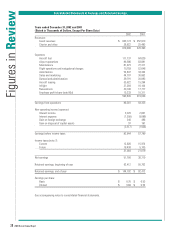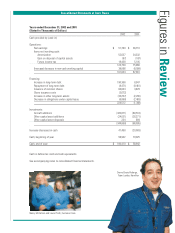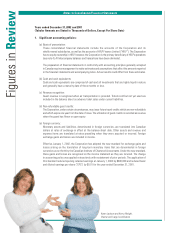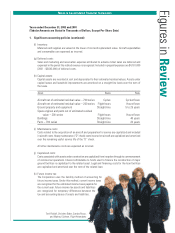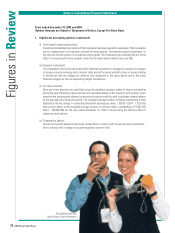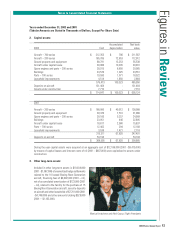Westjet 2002 Annual Report Download - page 33
Download and view the complete annual report
Please find page 33 of the 2002 Westjet annual report below. You can navigate through the pages in the report by either clicking on the pages listed below, or by using the keyword search tool below to find specific information within the annual report.
2002 WestJet Annual Report 33
2002’s capital expenditures totaling
$73.6 million with cash outlay in excess
of financing. Capital outlays of $344.9
million during 2002 were primarily
used for aircraft acquired in 2002,
which represented $212.4 million of
this total investment. The proceeds of
the Ex-Im Bank debt financing amount-
ed to $190.4 million.
During 2002, WestJet paid Boeing
further cash deposits on 2003 through
2006 deliveries totaling $108.5 million.
Other cash capital expenditures includ-
ed deposits on our second 737-700
simulator of $9.2 million, computer
hardware and software purchases of
$7.5 million, the Calgary and Hamilton
hangar construction of $9.2 million, a
$2.1 million fixed-base trainer that will
be installed upon completion of the
Calgary hangar expansion, spare
parts and tooling to support the
737-700 fleet of $5.8 million,
and airport and ground han-
dling equipment of $7.8
million. The unencumbered
capital assets such as hangar
facilities, our 737-700 simula-
tor and spare parts, and ground
handling equipment are avail-
able to pledge as security should
WestJet decide to finance a
portion of them with long-term
debt in order to increase our
current ratio.
WestJet’s total off-balance
sheet assets and liabilities relat-
ing to 10 737-700 and two 737-200
operating leased aircraft amounts to
$393 million at December 31, 2002 as
compared with $179 million at
December 31, 2001. Our total debt-to-
equity ratio, including the operating
leases, was 1.1 to 1 at December 31,
2001. The $82.5 million share issue in
2002, together with retained earnings of
$144.2 million, put WestJet’s total debt-
to-equity ratio on December 31, 2002
at 1.8 to 1.
This debt-to-equity ratio accom-
plishment is especially pleasing con-
sidering the addition to our fleet of six
737-700 operating leases and four 737-
700 aircraft with 85% Ex-Im Bank debt
financing. Our philosophy is to main-
tain a strong balance sheet with a
debt-to-equity range of approximately
2.0 or 3.0 to 1. These are enviable
measures in this industry, and they still
leave WestJet with ample room to con-
tinue our program of new aircraft
acquisitions.
EX-IM BANK FINANCING
The fourth quarter of 2002 marked an
important milestone for our Corpor-
ation as we completed financing
arrangements, supported by loan
guarantees from the Ex-Im Bank, for
US $477.8 million that is to be used
for the purchase of 15 Boeing
Next-Generation 737-700 aircraft.
Additionally, WestJet has received a
preliminary commitment from the Ex-
Im Bank for loan guarantees to
support the acquisition of the remain-
ing 15 Boeing 737-700 aircraft we
have committed to purchasing prior
to year-end 2006. Securing this
financing and additional Ex-Im Bank
guarantee has provided WestJet with
the ability to expand our fleet of Next-
Generation aircraft while
adhering to our low-cost
philosophies and maintaining
our strong financial position.
This facility will be drawn
in Canadian dollars in separate
instalments for each new air-
craft. Each loan will be
amortized on a straight-line
basis over the 12-year term in
equal quarterly principal
instalments, with interest cal-
culated on the outstanding
principal balance. During the
fourth quarter of 2002,
WestJet accepted delivery of
the first four of these aircraft
with the remaining scheduled to be
delivered prior to year-end 2003.
Having the ability to draw these
funds in Canadian dollars significantly
reduces the Corporation’s exposure to
foreign currency fluctuations as the vast
majority of our revenue is in Canadian
dollars. Prior to each delivery, howev-
er, WestJet is exposed to fluctuations in
the Canadian/United States exchange
rate as the aircraft are paid for at the
date of delivery in US funds. We feel
this exposure is mitigated as aircraft
deliveries are spread out over time, and
therefore WestJet will effectively
achieve an average rate of exchange.
...WestJet’s total
debt-to-equity ratio on
December 31, 2002
was 1.8 to 1. Anne Lindsay, Flight Attendant,
lends a helping hand in BeanLand.
Emily Little, SSA, flashes a big smile.


